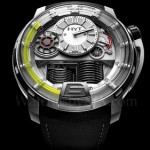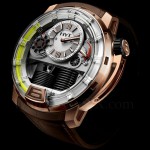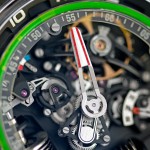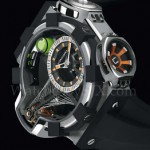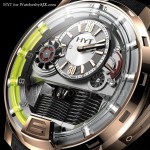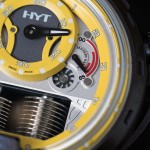Explaining The HYT H1, The World’s First Hydro-Mechanical Watch (With Live Photos And Price)
Last year HYT made its official debut with the H1. Equipped with a fluorescent green liquid hour indicator, the H1 was the world's first hydro-mechanical wristwatch. Thanks to its unusual brand of watchmaking, HYT is one of the most high profile emerging watch brands.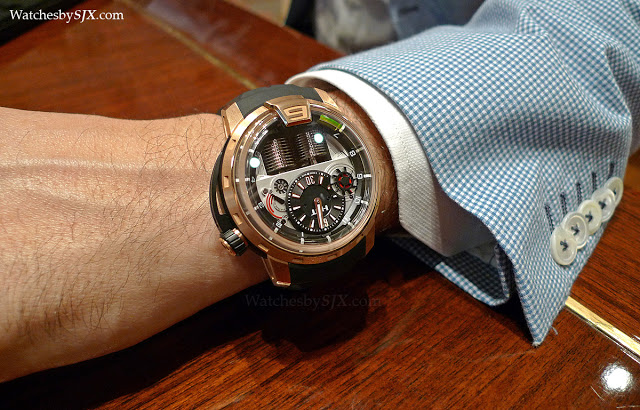
The novelty of the HYT H1 is derived from a simple premise: the liquid hour display driven by two bellows. Inside the thin, ring-shaped tube made from borosilicate glass (the kind used for laboratory glassware) are two liquids. Seven layers of coatings are applied to the inside of the glass tube to ensure the liquid travels perfectly smoothly through its entirety. Manufacturing a curved glass tube this fine was one of the biggest challenges in the development of the H1.
.jpg) |
| The HYT H1 in red gold and DLC coated titanium |
.jpg)
The two liquids are immiscible because of their composition: one is a water-based solution tinted fluorescent green, and the other is a clear, oil-based fluid. The meniscus between the two fluids indicates the hour. Because the water-based liquid is essentially water with pigments added, the possibilities with other colours are obvious.
.jpg) |
| HYT H1 in DLC coated titanium |
.jpg)
.jpg)
Two bellows at six o’clock drive the liquid forward – one bellows expands and the other contracts – until it hits six o’clock. At this point the bellows return to equilibrium, as the tip of the snail cam is reach and the pistons no longer apply force to the bellows.
.jpg)
.jpg) |
| The bellows and glass tube containing the fluid |
This causes the meniscus to travel back to the origin as the clear oil fills the glass tube, much like a retrograde hand. This, however, is not instantaneous, requiring about 50 seconds to complete. While that is happening the time mechanism continues to run, and there is no loss in accuracy.
.jpg) |
| The twin bellows seen from the back of the watch |
Because the force applied to the bellows need to be small but consistent in order for a linear motion of the liquid, the bellows are driven by a piston, which is in turn driven by a snail cam. Each bellows has a tiny degree of motion, of only about one millimetre.
.jpg)
.jpg)
The video belows shows the H1 in action. Ion Schiau, Vice President of Sales and Marketing at HYT, explains the time display of the H1, as well as demonstrates the retrograde function of the fluid hour display. One issue that emerged with some of the early H1 watches delivered was the change in liquid volume due to temperature. When the watch is not worn – on the wrist body heat keeps the watch at a sufficiently constant temperature – slight expansion or contraction in the fluid volume causes the hour indicator to deviate slightly from where it should be. To fix that problem, HYT has already devised a temperature compensating mechanism which will be built into the H1 movement. Though the key attraction of the H1 is obviously the liquid time display, the rest of the watch is well put together. The case is large, carefully made and well finished, with design elements that complement the engineered premise of the H1.
.jpg)
.jpg)
.jpg)
At 48.8 mm wide and 17.9 mm high, the H1 is a huge watch. But it is unexpectedly smaller than it actually is thanks to a practical case design. The lugs are short and curved downwards, allowing the watch to sit well on most wrists.
.jpg)
Visible through the back is the HYT cal. 101. The timekeeping portion of the movement is made by Chronode, run by Jean-Francois Mojon, while the liquid mechanics component is manufactured by Preciflex, the sister company of HYT. The two parts are then assembled by HYT at its offices in Bienne.
.jpg)
.jpg)
Preciflex is run by the trio of engineers who founded HYT, Patrick Berdoz, Lucien Vouillamoz and Emmanuel Savioz; with Vouillamoz being the one who originally conceived the idea of a hydro-mechanical watch. The H1 has only been around a year and there are obvious long term concerns about the durability and performance of the liquid time display. But the H1 seems carefully thought out and put together, and the team at HYT are serious minded people; I am inclined to trust them. The balance of probabilties are in HYT’s favour.
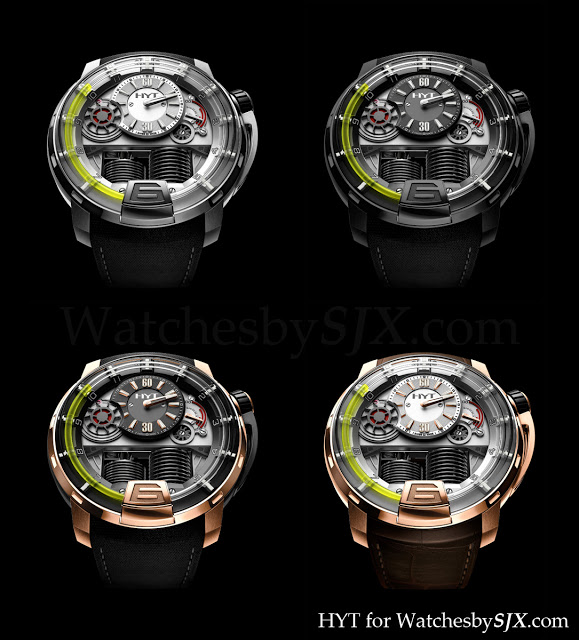
The H1 is available in four guises, pictured above clockwise from top left, titanium (US$47,000), DLC coated titanium (US$49,500), red gold and titanium (US$59,000), and all red gold (US$69,000). Scroll down for many more photos of the HYT H1. And don’t forget to read our coverage of the newly launched HYT H2. – SJX
.jpg)
.jpg)
.jpg) |
| HYT H1 in red gold and DLC titanium |
.jpg)
.jpg)
.jpg)
.jpg)
.jpg)
.jpg)
.jpg)
.jpg)
.jpg)
.jpg)
.jpg)
.jpg)
.jpg)
.jpg)
.jpg)
.jpg) |
| HYT H1 in DLC coated titanium |
.jpg)
.jpg)
.jpg)
.jpg)
.jpg)
.jpg)

